Hindu Death Rituals — Everything You Need To Know
Hindu culture follows the concept of Moksha. Moksha means liberation. According to India’s culture, the cycle of life, birth, and death occur once one gets Moksha or liberation.
In the Hindu religion, when someone dies, instead of Rest In Peace, it is customary to say “Om Shanti” or “Aatma ko Sadgati prapt ho” (May your soul attain Moksha). In Indian culture, sadgati means liberation and salvation. There’s a huge concept of Moksha in the Hindu death rituals.
What is death, according to Hindu?
According to Hindu mythology, death is a phase that one undergoes after the individual passes. In the Brihadaranyaka Upanishad, death is described as the passion of the soul.
Suppose the soul departs from the body, the breath, and life that follows end, and so do the organs. The soul is the one endowed with consciousness, and the body eventually goes into consciousness. After death, the soul relishes knowledge, work, and past experiences. There’s a difference between acts of good deeds and negative good deeds.
According to Hinduism, there are four courses that a person follows after death. The first stage is known as Devayana and is the spiritually involved. The second stage is known as the Pitriyana, describing the way of fathers.
As per Hinduism, death is the ultimate truth. It brings about a huge range of things. According to the Hindu scriptures, many souls are born as humans after death. The different stages of death help to boost the belief. It is said that these courses help to warn people against the neglect of self-knowledge, which can eventually bring about eternal peace, happiness, and immortality.
As per the Bhagavad Gita, “For whatever objects a man thinks of at the final moment, when he leaves the body- that alone does he attain, O son of Kunti, being ever absorbed in the thought thereof.”
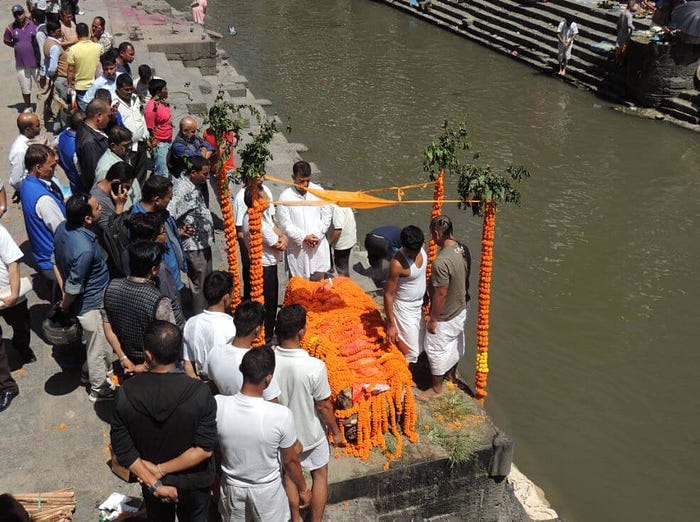
What is the Hindu ritual after death?
In the Hindu symbols, there’s a comprehensive set of rituals that are to be followed. Just like birth, Hindus believe that a set of rituals need to be formed after death.
According to the Hindu death rituals, the body should be kept at home until the cremation is done. The cremation is done only after 24 hours. Owing to Hindu cremation’s short time frame, the embalming process is often considered unrequited. However, it is necessary to hold a prayer ceremony at home after death by friends and family to observe individuals’ peace. Furthermore, the friends and family should visit the home of the deceased to offer sympathy.

Unlike other cultures, Hindus believe in keeping the dead body in a casket. The body donation completely depends on the individual. The length of service, however, depends on the individual. In Hindu death rituals, no recording devices are allowed, and the reading source is Mantra.
One needs to observe at least 10 to 30 days of mourning. Many people follow thirteen days of mourning where they do refrain from eating non-veg food. Furthermore, the sons are expected to cut their hair and devote it to the deceased.
Hindu Funeral- What is it exactly?
Funeral in Hinduism is known as Antyeshti or last sacrifice. The Antyeshti ceremony is completely dependent on gender, caste, and age. As per Antyeshti, the body needs to be cremated. Furthermore, it is also known as antim sanskar.
The open casket is carried to the crematorium for the Hindu funerals, with the feet entering the first, and the mourners recite the prayer. According to Hindu rituals, the casket is kept open so that the guests can view it. The Hindu priests and family members will carry out the cremation ceremony known as Mukhagni.
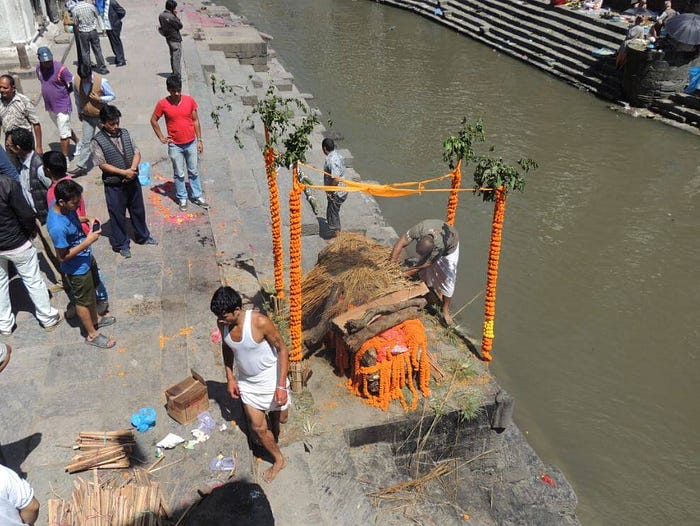
In Hindu culture, Mukhagni is done by men. However, in modern times, even women are allowed to attend women, which initially wasn’t done. Once the funeral pyre is lit, the ashes are scattered on the Ganga, which is considered one of the holiest rivers as per Hindu symbols. Apart from that, as per the last wish of the deceased, his/her ashes may also be spread over the place of their choice.
In the Hindu funeral rites, the priests chant mantras or even the eldest son of the bereaved. The eldest son or priest brings about friends and family to conduct the different rituals of Hindu funeral.
The commonly performed Hindu death rituals include
- Washing the dead body using holy water, ghee, honey, and yogurt
- Place the essential oils on the deceased’s head (for females, turmeric is preferred, and for male, sandalwood is preferred)
- The big toes are tied together, and palms are placed in the position of prayer.
- Dress the deceased in contemporary clothes and tie the body with a white sheet known as kafan
- Place a garland around their neck.
- Light a Diya near the head of the body and sprinkle water over the dead body
What happens during the Hindu funeral?
During the Hindu funeral, a comprehensive set of regulations is followed. Once the death occurs, those around are advised not to touch the body because it is considered impure.
The preparation of the funeral starts immediately. The funeral, as suggested, should be completed within the next dawn and dusk. The priest is called to help with the decision-making process and directs the Hindu-friendly funeral process. Organ donation is also accepted in Hindu laws. Embalming is acceptable as well, but it is not necessary.

Close friends and family members wash the body. Many Hindus consider this to be an important part. While washing the deceased, the head should be placed southward. The lamp should be lit. As suggested, the body should be washed in purified water using a mixture of yogurt, ghee, and milk.
However, while the body is being washed, the priest recites the mantra. After the body is washed, the two toes should be tied together and shrouded with a white sheet. However, if a married woman dies before her husband, she should be wearing a red dress.
According to Hindu culture, there should be a proper brief of cremation. The body is kept in a simple, inexpensive casket. The chandanam or vibhuti is applied on the man’s forehead, and turmeric should be applied for women.
Along with a garland, holy basil should also be kept around the casket. During the wake period, family and friends surround the casket and chant hymns. However, when the wake is finished, the body is removed for the cremation process, and the ‘pinda’ or rice balls are kept near the casket. When the casket is being removed, the feet should be brought first to the place of cremation.
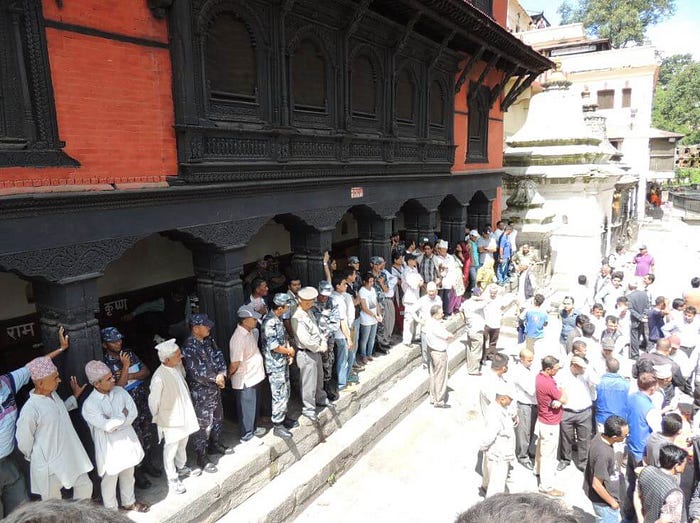
As per the Hindu culture, cremation is done near the Ganges river. The body is placed on a funeral pyre and burnt. The Karta, or one who lights the funeral pyre, takes three rounds across the body. For Hindus living outside the country, many companies work on shipping the body to the country, with a proxy Karta to conduct the ceremonies. After the cremation is done, the ashes are taken home or scattered in the river.
After the cremation is done, the family members return home, bathe and change into fresh clothes. They gather for a meal, and the priest lights an incense stick.
Hindu Ashes Scattering Ceremony
It is always a traumatic experience to lose a loved one. According to the Hindu culture, the dead body should be cremated within 24 hours of death. The ashes are then taken to the sea or a water body and scattered into it. However, many people also scatter the dead body’s ashes in the deceased’s favorite place only if they wish to do so.
As per the Hindu death rituals, the cremated ashes may either be sprinkled or dispersed in the ocean or the water that flows into it. It is believed that immersing or dispersing ashes into the water body will only help them to transport the soul to their afterlife.
In India, it is believed that scattering the ashes into the Ganga will either help the deceased have a comfortable afterlife or attain Moksha.
Hindu Rituals after the death of Mother
The Hindu death rituals vary for that of the mother and father. Hindu culture pays heed to the Hindu Gods, and it is said that the souls after death become divine beings too and are treated accordingly.
According to the Garuda Purana, the family members become unclean or a-swachh after their loved ones’ death. Hence, it refrains the family members from visiting a temple because they are impure.
After the death of the mother, the sons and daughters are expected not to consume milk. Furthermore, if the mother dies before the father, she should be adorned in her wedding clothes or red saree. The sons are expected to light the funeral pyre.
Hindu rituals after the death of the father
According to the Hindu death rituals for the father, the body needs to be burnt, and the children are advised to give up consumption of bananas and curd. The rice balls are to be placed near the dead body, and holy water is expected to be spread over the dead body. Furthermore, the holy basil leaf should also be placed on the dead body.
Many Hindu families observe 16 days of mourning after the father passes away. The son needs to shave his head.
The Hindu death rituals need to be performed accurately to elevate the mind, soul, and body. It is said that doing so rightly can help change an object's nature and give it a new look.

Hindu Baby Death Rituals
As stated above, in Hindu culture, the dead bodies are cremated. However, the crematorium may not be valid for the corpses of children under three. Many Hindus cite that the corpses of these children should be submerged in holy rivers or buried.
When the child is dying, they are not placed on the ground but are allowed to expire in the mother’s arms. For such children, no special death rites are performed. In the Hindu tradition, it is believed that the child becomes a victim of such karma because he or she must have been a monster or done evil deeds in their previous birth.
The funeral ceremony of a dead child is shorter and lasts for three days. However, in high-caste people like Nagaras, if the pregnant woman dies, the dead fetus is removed and buried in the same place where the mother is being cremated.
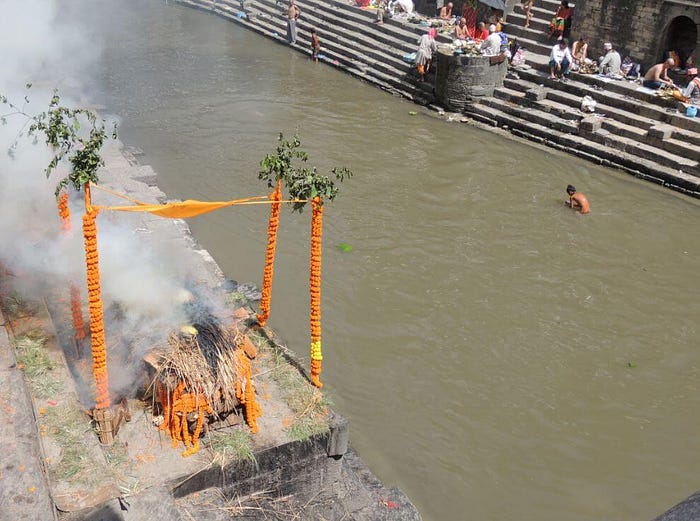
What is the dress code in a Hindu funeral?
People visiting the funeral must wear white clothes. The clothes should be traditional and nothing modern. White symbolizes peace, and it is believed that wearing so during a funeral might bring peace to the deceased.
The dress code for men as well as women is casual. It is customary to cover the head. The women should be dressed conservatively, and the arms and knees should be covered. However, while many women refrain from wearing jewelry, this practice is still acceptable.
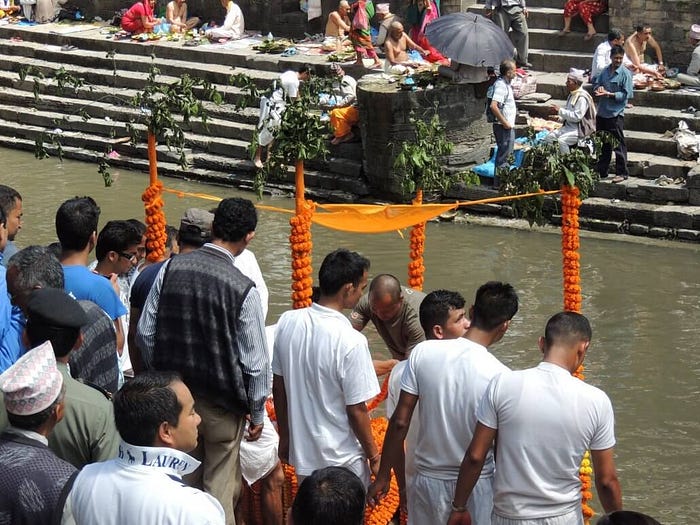
Hindu funeral etiquette
As per the Hindu culture, one should be dressed in white while visiting the deceased. The mourners are expected to dress casually at the service. One should be silent during the funeral process. Many people prefer calling and offering condolences to the loved ones after a loved one passes in their family.
Many Hindu families hire women to cry at the ceremony. Although absurd, it is showing respect to the deceased. This culture of hiring a group of women to cry at the funeral service is predominant in Rajasthan. While the people visiting the deceased are expected not to carry anything to the funeral space, many carry fruits and flowers to space.
What is Mundane, and why it’s done after death?
Shaving the head is known as mundane. The sons usually do Mundan. Monday is usually done after the death of an elderly member. It is said that shaving off the hair only helps men to let go of their ego.
Shaving the head is a sign of them taking up the responsibility and reminds the men to be obedient. This helps them become more selfless while conducting their deeds.
Moreover, for outsiders, mundane also shows that an unanticipated event has taken place within the family. Many people believe that shaving the hair also helps to prepare the person regarding what lies ahead. Shaving the head acts as a mark of respect to the deceased and reflects the highest satisfaction.
Hindu Death Condolences
When someone dies in the family, condolences are offered. Rest in peace is not a tradition, but it is to attain Sadgati and Moksha. Instead, in Hindu culture, people say ‘Atma ko Sadgati Prapt ho’ and ‘Om Shanti.’
If someone is in your known circle, you should call the loved ones and offer them condolences and strength. You should send love and prayers. May God give you the strength and comfort to mourning the loss.
One of the most common condolences you can give to your loved one is:
“May you find rest and comfort in the love and hope of God and others that surround you.”
“May God and the caring love and thoughts from others help you to get through your sorrow.”
Hindu Mourning Period
According to Hindu mythology, the mourning period ranges from 10 to 30 days. However, a year is considered to reach purity. In this mourning period, the families keep the picture of their loved ones in the display, and the picture is adorned with flowers. Throughout these days, visitors are welcomed and prayed with a garland of flowers.

Hindu Death Rituals 10th day
As per the Hindu rituals, they are barred from consumption of non-vegetarian food, oil, and salt. The food consumed should be bland. While some people follow it for 13 days, some follow it for ten days as well.
What is called the 12th day after death?
The 12th day after the death is referred to as Sapindikarana, where the Hindu death rituals are conducted to help the soul transcend to the pitru Loka. In the pitru loka, the soul of the deceased merges with the forefathers. On the 12th day after the death, all close friends and family members are called to the Sapindikarana.
This ceremony is often conducted on a large scale among many Hindu families. As per Hindu beliefs, many people conduct donation drives to donate food and money as a mark of respect for the deceased.
Why are there 13 days after the death?
The 13th day after death is known as tehravin or the thirteenth. A large scale ceremony is conducted where the death is mourned. The community function is organized for the people of the locality in memory of the dead person. The tehravin is performed at a large scale if the person was popular in the locality or are socially prominent.
Earlier, the cause of death was unknown. Hence, it was tough to find if the cause of death was a virus or infection. Apart from the religious explanation, the thirteen days were also observed scientifically to keep the family isolated.
Hindu death rituals after a year
On the death anniversary, an acknowledgment ceremony is conducted to pay homage to the deceased. Many people perform puja at home as a mark of respect. Here are the common Hindu death rituals after a year
- Visit the final resting place of the deceased.
- Hold a special remembrance or ceremony.
- Express a loving sentiment.
- Feed the poor.
Takeaway
The Hindu death rituals aren’t complicated, but they’re very rigid. It is necessary to perform these rituals with proper diligence. A priest needs to be called to conduct the rituals. The family members can observe a period of mourning.
This article originally published at https://east-asian-cultures.com/hindu-death-rituals/
